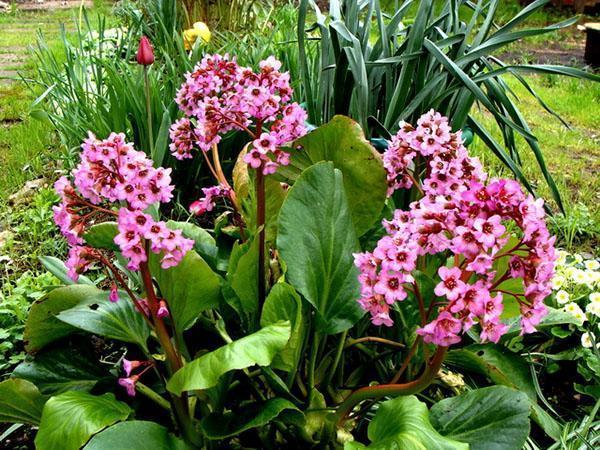Choosing a companion for an amazing badan
 A sense of style will help the florist create a heavenly idyll in his flower bed. Amazingly hardy incense in combination with other flowers, they can make a fabulous extravaganza. The growth and shape of the leaves of the future companions of bergenia are especially carefully selected. Here are some variations on these amazing fellowships.
A sense of style will help the florist create a heavenly idyll in his flower bed. Amazingly hardy incense in combination with other flowers, they can make a fabulous extravaganza. The growth and shape of the leaves of the future companions of bergenia are especially carefully selected. Here are some variations on these amazing fellowships.
Culture was brought to Europe from St. Petersburg in 1760. Karl Linney researched the plant and named it according to its basic characteristics.
Eternal trio
The classic combination of round, xiphoid and cut leaves is always welcomed by designers. Moreover, varieties with such parameters are of high growth. Some varieties of badan produce peduncles up to 70-100 cm. Only fluffy Volzhanka can compete with them. Cut leaves of a flowering shrub will dilute a dense forest of large-leaved greenery. This effect can be expected from irises... The long xiphoid foliage of the culture is in perfect harmony with the round blades of the bergenia. If you add a few copies of tulips to this "senate", the result will surpass all expectations.
Badan is considered an evergreen and frost-resistant variety. Nevertheless, to preserve its decorative properties for the winter, they cover it. To do this, use spruce needles or spruce, branches, as well as rotted leaves.
Building a pyramid
Words disappear, and emotions simply overwhelm when a multi-tiered flower bed appears. Especially impressive is the multi-colored palette created from several types of plants. The composition is complemented by exotic trees. Place an unusual collection on alpine slides. Thanks to this combination of crops, the land is retained during landslides and heavy rainfall. They build a landscape "pyramid" from:
- Valdsteinium trifoliate, which creates a thick "Persian carpet" of a rich yellow hue;
- bright blue miniature umbilical flowers;
- lilac sea of luxurious badans with large leaves;
- sprawling "tent" of sakura.
In spring, this corner takes on a magical look. The play of contrasts is possible thanks to the colors yellow, pink and blue. Moreover, each plant plays its part in this symphony of colors.
Ground cover varieties have several characteristics. They are small in stature, so they can create carpet. At the same time, the culture is growing rapidly.
Badan is often planted in order to hide technical or unsightly areas in the country. The flower stems develop so quickly and densely that they leave no chance for weeds. They are also placed in tandem with yellow chamomile, which fades in the middle of summer, leaving a noticeable gap in the flower bed. If you plant bergenia next to it, then this place will not be so deserted. At the same time, varieties of the Sino-Himalayan group are distinguished by white flowering and pubescent leaves. Unfortunately, they cannot stand harsh winters, but they look great with peonies.